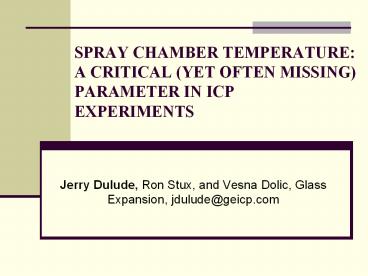SPRAY CHAMBER TEMPERATURE: A CRITICAL (YET OFTEN MISSING) PARAMETER IN ICP EXPERIMENTS - PowerPoint PPT Presentation
Title:
SPRAY CHAMBER TEMPERATURE: A CRITICAL (YET OFTEN MISSING) PARAMETER IN ICP EXPERIMENTS
Description:
SPRAY CHAMBER TEMPERATURE: A CRITICAL (YET OFTEN MISSING) PARAMETER IN ICP EXPERIMENTS Jerry Dulude, Ron Stux, and Vesna Dolic, Glass Expansion, jdulude_at_geicp.com – PowerPoint PPT presentation
Number of Views:89
Avg rating:3.0/5.0
Title: SPRAY CHAMBER TEMPERATURE: A CRITICAL (YET OFTEN MISSING) PARAMETER IN ICP EXPERIMENTS
1
SPRAY CHAMBER TEMPERATURE A CRITICAL (YET OFTEN
MISSING) PARAMETER IN ICP EXPERIMENTS
- Jerry Dulude, Ron Stux, and Vesna Dolic, Glass
Expansion, jdulude_at_geicp.com
2
Focus of this study on ICP-OES
- Effect of Spray Chamber Temperature on
- Analyte sensitivity
- Detection limits
- Matrix interferences
- Plasma robustness
3
Experimental
- PE 2100 Optima DV
- Power 1450 watts
- Coolant gas 15LPM
- Aux. gas 0.2LPM
- Neb. Gas 0.7LPM
- SeaSpray concentric glass nebulizer
- IsoMist Programmable Temperature spray chamber
with Twister Baffled Cyclonic
4
IsoMist on Optima 2100DV
5
IsoMist Characteristics
- Programmable from -10 to 60C in 1 degree
increments - Maintains temperature to within 0.1 degree
- Built-in Peltier device
- Temperature measured near the chamber surface
- No external plumbing
6
Effect of Temperature on Normalized LOD (20ul/min
Uptake)
PE Optima 2100DV
7
Effect of Temperature on Normalized Intensity (20
uL/min)
PE Optima 2100DV
8
Transport Efficiency vs. Uptake Rate
9
Unexplained Intensity Enhancement
The Phenomenon
- 200 enhancement at 60C
- 67 possible from transport efficiency
- Where is the missing 133?
- Higher energy plasma
- Smaller mean droplet size
Theories
10
Theory of Sensitivity Enhancement
When water is the solvent, an increase in the
solvent loading under robust conditions leads to
an increase in the MgII/MgI ratio. the
generation of hydrogen will increase locally the
thermal conductivity of the discharge.
Todoli and Mermet, JAAS, Aug., 1998, Vol. 13,
p.730
11
Humidification Test
- Measure intensity in bypass mode.
- Switch to humidification ON mode
- Re-measure intensity without changing conditions
Capricorn Argon Humidifier
12
Effect of Humidification on Intensity(100ul/min
uptake rate)
13
Theory of Intensity EnhancementSmaller Mean
Droplet Size
- Initiate evaporation in the chamber
- Smaller particles reach the plasma
- More efficient atomization
- Higher intensity
- Use phase Doppler particle analyzer to measure
mean droplet size
14
Sensitivity vs. Temperature(1ml/min uptake)
15
Intensity and Transport Efficiency vs Temperature
16
Temperature vs. Robustness(Mg/Mg Ratio) 1ml/min
uptake
1000ppm Na K 500ppm Ca
17
Temperature vs. Suppression(1ml/min uptake)
1000ppm Na K 500ppm Ca
18
Suppression and Intensity vs. Temperature(average
of 18 lines) 1ml/min uptake
1000ppm Na K 500ppm Ca
19
Summary
- Spray chamber temperature is a critical parameter
in ICP-OES experiments. - Intensity is proportional to temperature.
- Suppression is unrelated to temperature.
- Plasma robustness increases with temperature.
- Constant temperature is important for all
analyses.































